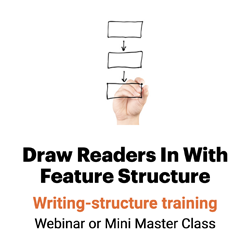Credit Union explains EQ in a feature
“Always grab the reader by the throat in the first paragraph,” said Time magazine reporter Paul O’Neil. “Sink your thumbs into his windpipe in the second and hold him against the wall until the tag line.”

How do you keep attention from the first paragraph through the tagline? Writing structure makes all the difference in how riveting your story can be.
Just ask Kathleen Sullivan, communication manager at Local Government Federal Credit Union. During my Get Clicked, Liked & Shared workshop, Kathleen reorganized a blog post from the inverted pyramid into the feature structure.
The feature approach convinces lots of people to read your post — and share your post. Plus, it’s a step-by-step structure that shows writers clearly what goes where.
Want to write successful blog content? What can you learn from Kathleen’s original and rewrite?
1. Lead
The job of the lead is to grab readers’ attention and draw them in.
In the original, Kathleen focuses on how the sausage was made … the abstract process behind the findings. Yaaaawn! Who cares about these interviews? Not me!
But Kathleen’s revision gets me, the reader, into the story. Moreover, she sets up a surprising scenario that grabs attention and pulls readers into the piece.
2. Nut graph
The job of the nut graph is to tell readers where you’re taking them.
Inverted pyramids don’t include nut graphs, so Kathleen’s original story skipped this element too.
But in her revised blog post, Kathleen encapsulates the main point in one quick, informal sentence:
3. Background section
In the background section, give readers information they need to know before they dive into the body of the story. That might be a definition, bit of context or history lesson.
But background is also known as blah-blah. Don’t let blah-blah get between your readers and your story: Keep this to one short paragraph.
In her original version, Kathleen delivers too much background, at 270 words.
And it’s too technical: Adaptive regulation? A combined perceptive and cognitive integration of emotions? Correlated to a positive orientation? Negative early engagements? No, thank you!
The adaptive regulation of emotion is called “emotional intelligence.” Psychologists say emotional intelligence is a combined perceptive and cognitive integration of emotions. A higher emotional intelligence is correlated to a positive orientation toward money and a greater sense of economic self-worth.
When one’s perception of money is rooted in a negative emotion – such as anxiety, guilt, or fear – impulsive and possibly destructive financial habits may follow. These perceptions are usually developed at an early age, when parents may unwittingly – or perhaps intentionally – share their own emotions with regard to money.
Regardless of how you view money, individual positive or negative financial circumstances play a defining role in your life. After all, money can provide freedom, security and safety. The lack of money can leave you feeling vulnerable, trapped or frustrated with limited options in life.
Since emotion is usually the fuel of behavior’s engine, pinpointing the source of negative emotion toward money is vital. Research suggests that negative early engagements with money may have forced financial deprivation or perhaps, instilled the perception that money was an elusive but crucial element for happiness during one’s upbringing.
Once an intense reaction to money is identified, steps can be taken to control or even eliminate behaviors that sabotage financial security.
The most effective way to improve emotional intelligence with regard to money is to identify, rather than avoid, a financial concern. Recognizing money woes or acknowledging personal financial irresponsibility is the start of building better EI.
Kathleen’s revised background section is still a little long for my taste. But at 109 words, it’s 60% shorter than the original.
Her words are also shorter — about 10% shorter — and easy to read and understand. Now it sounds as if she’s telling me about this story on the elevator on our way to lunch.
Even better: It’s about me!
If your view of money stems from negative emotions — like anxiety or fear — harmful financial habits may follow. These ideas usually develop early, when your parents may have shared their own ideas of money.
Regardless of your money view, your financial health plays an important role in your life. Money can provide freedom, security and safety. A lack of money can leave you feeling anxious or frustrated.
Recognizing money woes or admitting financial irresponsibility is the start of building better EI.
4. Body
The body is where you develop your story.
In Kathleen’s original, the meat of the story — the tips — are buried under 296 words of abstraction.
Plus, do’s and don’ts usually have a format: DO do this. DON’T do that. But instead, Kathleen used nouns. Those aren’t tips.
- Denial: Don’t ignore signs of financial peril.
- Escape: Don’t fall back into patterns that reinforce unhealthy financial behavior. Most patterns – regardless of the damage they may cause – are still familiar and comfortable.
- Awareness: Do stay aware of account charges, bank balances and other financial data that help you stay informed of your financial health.
- Plan: Do create a proactive plan and establish goals. This will help to decrease the intensity of an emotional reaction to money and can improve overall EI.
In her revision, Kathleen gets to the meat of the story faster and adds more detail. She also formats the tips as tips, not as things:
Psychologists also recommend the following do’s and don’ts for improving EI:
- Don’t ignore hints of financial peril, like poor credit scores, calls from collections agencies or other signs.
- Don’t lapse back into unhealthy financial behavior. Patterns are still familiar and comfortable despite the damage they may cause.
- Do stay aware of charges, bank balances and other financial data that help you focus on your finances.
- Do create a plan with goals. This will help reduce the intensity of an emotional reaction to money.
5. Wrapup
The job of the wrapup is to draw to a conclusion. Do you have a call to action? It goes here.
Here’s Kathleen’s original, packed with technical language:
Her revised piece is shorter and easier to read:
Improving EI also can help you avoid buyer’s remorse today and achieve your financial goals tomorrow.
6. Kicker
The job of the kicker is to end with a bang, to leave a lasting impression.
Inverted pyramids don’t include kickers, so Kathleen’s original doesn’t, either.
But in the revision, she ends with a bang in a concrete, creative provocative final paragraph. Notice how she comes full circle back to the top.
So what’s the best blog post structure?
Writing structure is such one of the most important writing skills. Before you start writing a blog post or other social media piece, spend a few minutes organizing it into this structure.
Whether you’ve just started blogging or are already a pro:
- Start your content marketing piece with keyword research.
- Use the feature structure.
- Optimize your copy so search engines can find you.
Whatever your topic, create a blog post that keeps readers riveted from the first paragraph to the last line.

Leave a Reply